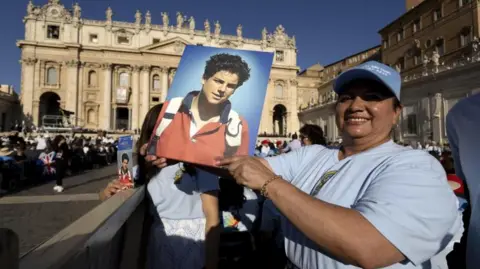A London-born boy has become the first millennial saint, in a ceremony steeped in an ancient ritual presided over by Pope Leo on Sunday.
In his short life, Carlo Acutis created websites documenting 'miracles' as a means of spreading Catholic teaching, leading some to nickname him God's influencer.
His canonisation had been due in late April, but was postponed following the death of Pope Francis.
More than a million people are estimated to have made a pilgrimage to the Italian hilltop town of Assisi where Carlo's body lies, preserved in wax.
But there is another pilgrimage site associated with Carlo Acutis that has seen an increase in visitors since it was announced that he was to be made a saint - Our Lady of Dolours Church in London. The font at the back of the Roman Catholic church in the Chelsea area was where Carlo was baptised as a baby in 1991.
To the side of the church, an old confession booth has been converted into a shrine to him, containing a single strand of Carlo's hair.
Carlo was not yet six months old when his parents moved back to their home country of Italy, and he spent the rest of his life in Milan. There, he was known for a love of technology and is said to have enjoyed playing video games.
While some who knew Carlo Acutis said he did not appear to be especially devout, as a teenager he created a website in which miracles were documented.
He died of leukaemia aged just 15. In the years after his death, Carlo's mother, Antonia Salzano, visited churches worldwide to advocate for him to be a saint, with the requirement of proving that he had performed miracles.
The first miracle reportedly occurred on the day of his funeral, when a woman prayed to Carlo for help with breast cancer; her cancer subsequently disappeared.
Pope Francis attributed two miracles to Carlo Acutis, leading to his canonization.
Some followers who had travelled to Rome for the canonisation found themselves among the mourners at Pope Francis' funeral. Diego Sarkissian, a young Catholic from London, expressed a connection with Carlo, noting that 'the fact that you can think of a saint doing the same things [as you], wearing jeans, it feels so much closer than what other saints have felt like in the past.'
Approval for sainthood can take decades; however, Carlo's quick canonization signifies the Vatican's effort to inspire and energize youth in faith.





















